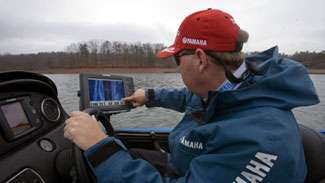
(Editor’s note: The following article is from the April 2008 issue of BASS Times. Subscribe today.)
GREENVILLE, S.C. — Every now and then, new technology leaps from the competitive fishing arena and changes the sport of fishing forever.It happened with soft plastics, high-tech braided lines and global satellite technology. And we may have just witnessed the official launch of another new technology at the 2008 Bassmaster Classic in South Carolina.Texas BASS pro Alton Jones won the $500,000 winner’s purse by targeting an extremely deep strike zone. But his search for that strike zone was not conducted in a random, haphazard manner. His most important tool was a new type of side-scanning technology that isn’t defined by pixel arches and blips of light.The electronic technology utilized by Jones in the Classic was the new Humminbird 1197c, which features both side-imaging technology and GPS chart plotting.
|
“I would not have won the Classic without it,” he told BASS Times.
Side-imaging sonar has been around for decades in one form or another. But the level of sophistication and degree of technology built into this new Humminbird unit, compared to the early version of side-imaging technology, would be like comparing an F-16 Tomcat with the aircraft of Orville and Wilbur Wright.
“It’s that amazing,” said Jones.
His overall game plan going into the Classic was relatively simple.
Based on the seasonal phase and the water temperature (48 to 50 degrees), Jones knew he had to find prespawn bass and they would be located in deep water. More importantly, he wanted to pinpoint an area that would deliver strikes each day of competition. Thus, he needed a migration route offering adjacent cover that would hold bass in the same general location.
Armed with this knowledge, he began searching Hartwell using his Humminbird 1197c and he eventually found a potential strike zone that was hidden offshore beneath 30 feet of water. And, incredibly, he was able to return to this same location each day of the Classic — and evaluate its potential before making the first cast.
|
|
You read that correctly. He was able to see his strike zone, using the “painted” electronic image provided by the 1197c’s large 10-inch diagonal screen.
As you can see from the last screen shot, which was “captured” in the immediate vicinity of Jones’ strike zone during the Classic by Humminbird technicians, the barren ditch where many of the fish were caught is clearly visible beneath the boat, along with several schools of — presumably — blueback herring in the middle of the ditch.
Additionally, the final image clearly shows the submerged timber adjacent to this prespawn migration route, together with the scattered wood debris along the bottom where he connected on many of his “jig” strikes.
Perhaps the biggest testament to this new technology is the following statement from Jones, referring to what might be hidden away inside a growing number of boats in the Elite Series.
“Even guys not sponsored by Humminbird have these units under their consoles when they’re fishing offshore structure,” Jones stated.
The only drawback might be the suggested retail price — the 1197c lists for $3,000.
But don’t ask Alton Jones if this new technology is worth the price.




